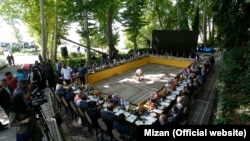In a letter to the UN special rapporteur for human rights in Iran, the Nobel Peace Prize laureate Shirin Ebadi has condemned a visit by 45 foreign ambassadors to Tehran’s infamous Evin prison, as “a state-choreographed visit”.
The ambassadors’ visit to the prison on July 5 was praised by the deputy secretary general of Iran’s Islamic human rights headquarters, controlled by the judiciary.
“The prison’s condition and social workers serving there amazed the ambassadors,” maintained Kazem Ghariabadi.
However, the visit -- guarded by state minders and preceded by a red-carpet welcome -- excluded certain areas of the prison, according to political prisoners currently held there.
“On the day of the ambassadors’ visit, at least 20 political prisoners and financial convicts were transferred to Ward 2-A under the control of the Islamic Revolution Guard Corps (IRGC) and told they were going to be taken to court,” Ebadi revealed in her letter to Asma Jahangir, the special rapporteur.
“Strangely enough, the esteemed ambassadors did not even visit the political wing of the Women’s Ward, where 24 political prisoners and prisoners of conscience are being held, including Narges Mohammadi, Nazanin Zaghari-Ratcliffe, Atena Daemi, and Azita Rafizadeh, who I’m sure had a lot to share with the ambassadors,” Ebadi confided with Jahangir.
Earlier, imprisoned human rights activists Daemi and Golrokh Iraee had addressed a letter to the ambassadors, inviting them to visit prisons in Iran without a formal prescheduled, staged, or choreographed plan.
“Did they give you a tour of Ward 209, Ward 2-A, or Ward 241? Did they show you the solitary cells without windows, ventilation, or toilets? What about the cells known as the graves?” the Center for Human Rights in Iran (CHRI) quoted the letter as saying.
Ward 2-A is under the control of the IRGC, while the Intelligence Ministry controls Ward 209, and Ward 241 is run by the judiciary’s intelligence branch, CHRI reports.
Meanwhile, in an article for the British daily Independent, Amnesty International Iran researcher Raha Bahraini said, “[So-called] excellent facilities were showcased, including an in-house beauty salon, a gym, a library, and even a restaurant,” concluding, “This wasn’t a genuine prison visit; it was crude political theater.”
Daemi and Iraee were also deeply disappointed by the visit, addressing the ambassadors, “Did they inform you of the existence of Ward 350, where male political prisoners are held? Or the ward that is exclusively for convicted clerics? Did they tell you about prisoners such as Mohammad Ali Taheri [a faith healer reportedly sentenced to death], who has been in solitary confinement for more than five years in IRGC’s Ward 2-A?”
Nevertheless, the judiciary’s official news website, Mizan, described prison cells as "mind-soothing, comfortable rooms,” each beautifully furnished with “six beds in uniform red covers” as well as “uniform relaxing carpets.”
Mizan has also indicated that at Evin, “no prisoner is deprived of having a physician” and “citizens’ rights” are the “prison personnel’s motto.”
Evin’s physician and his practice, incidentally, is a topic highlighted in Daemi and Iraee’s letter to the ambassadors.
“Did they introduce you to a physician aliased Shahriari? He’s the one who finds out what’s wrong with sick prisoners just by glancing at them. He’s the one who never dares to sign his name because he’s scared of the day he will be exposed for his malpractice.”
In June 2016, CHRI published a report on the Women’s Ward of Evin, documenting the routine denial of medical care and hospitalization and severe restriction or denial of visitation rights even with the women’s young children.
Political prisoners in Iran, including elderly inmates, are singled out for harsh treatment, which often includes denial of medical care. The threat of withheld medical care has also been used as an intimidation tool against prisoners who have challenged the authorities or filed complaints, CHRI reports.










